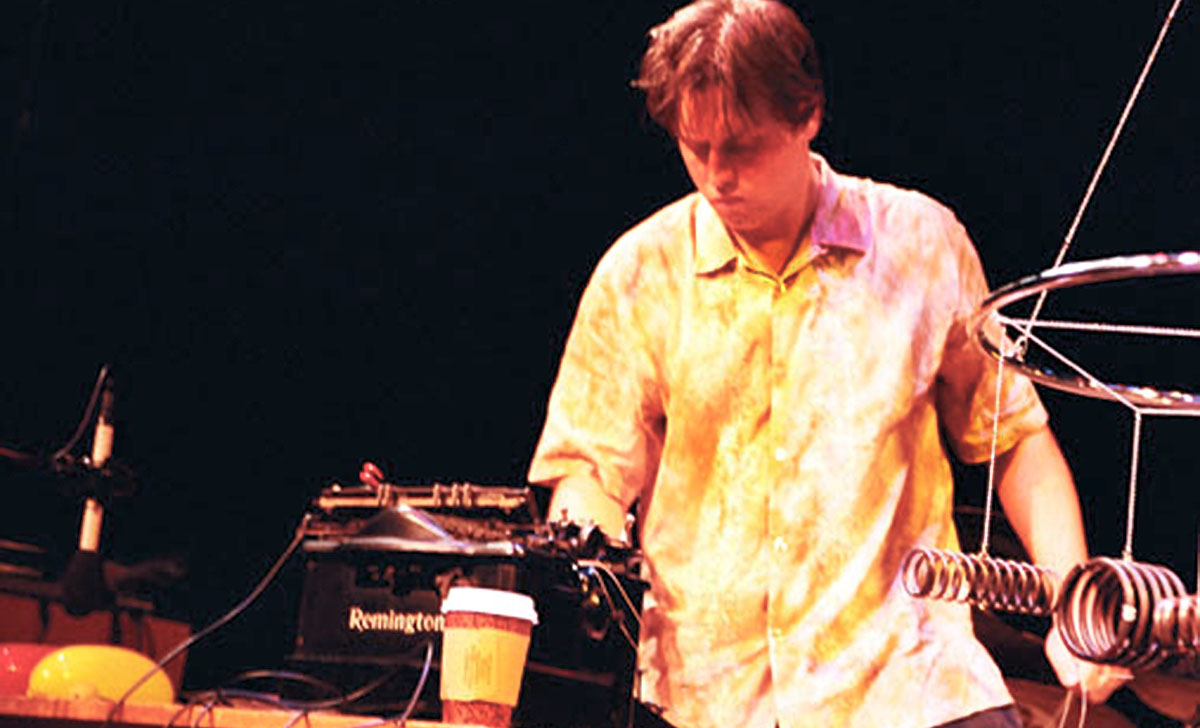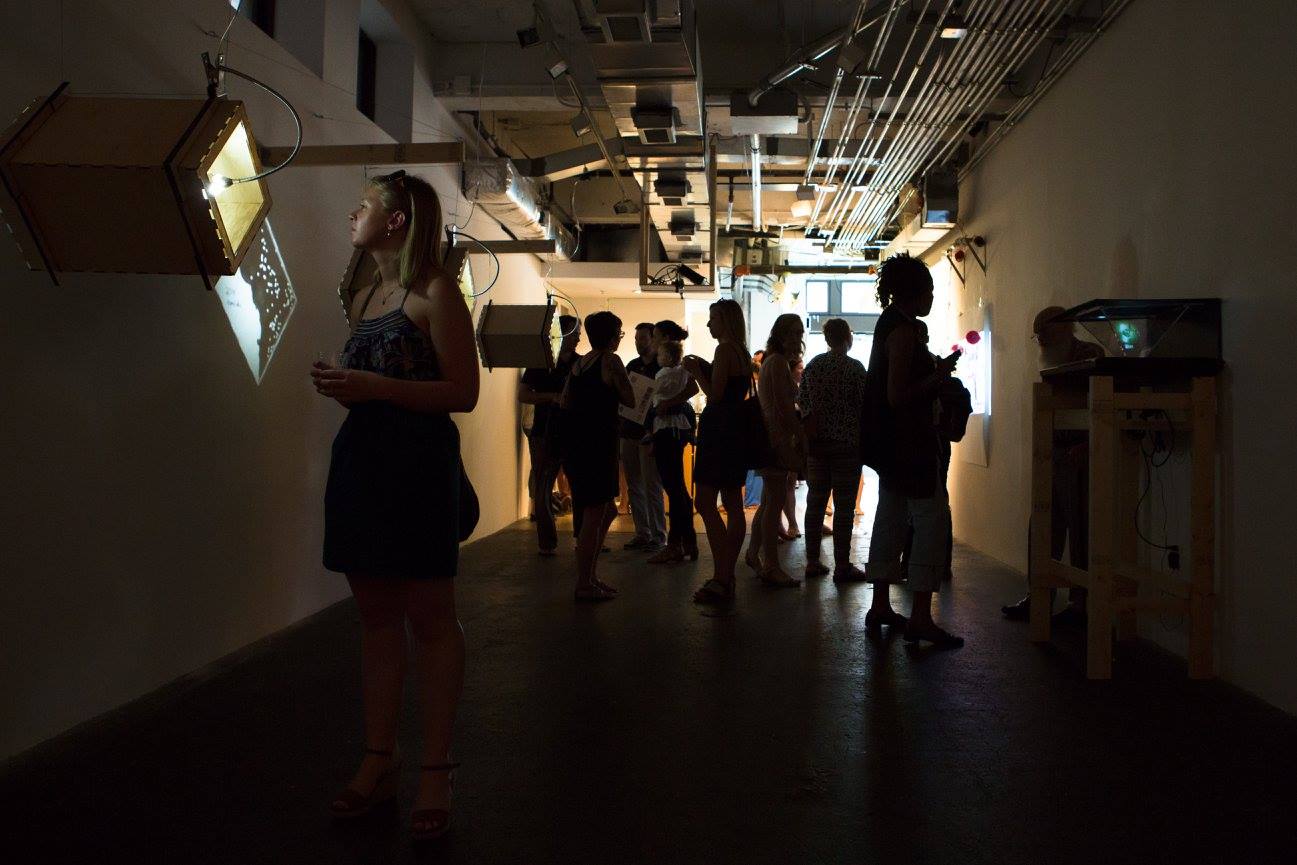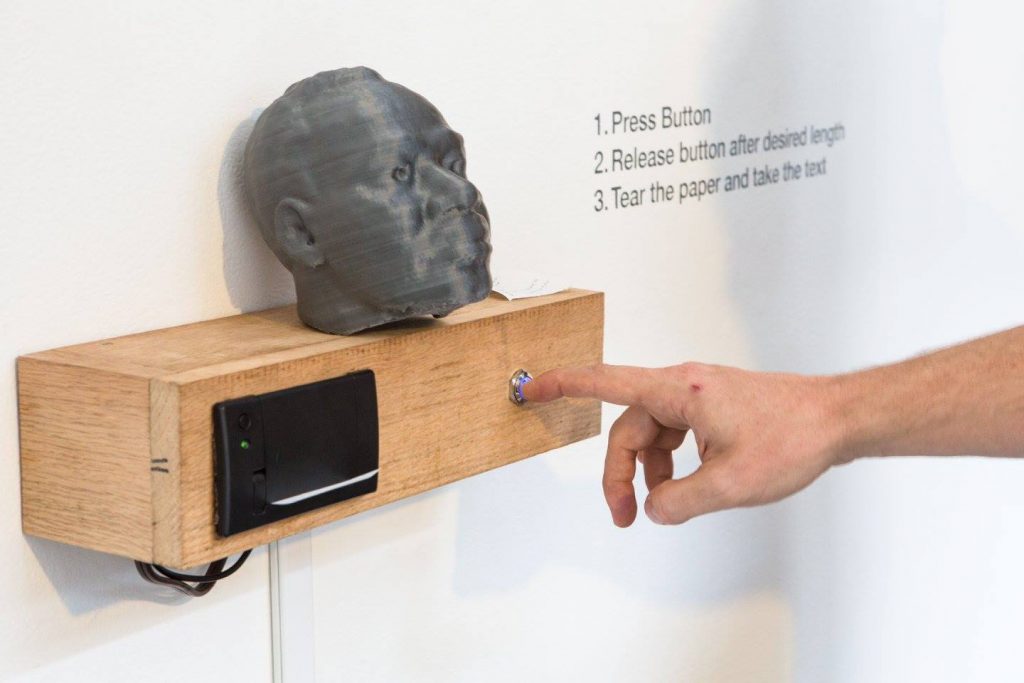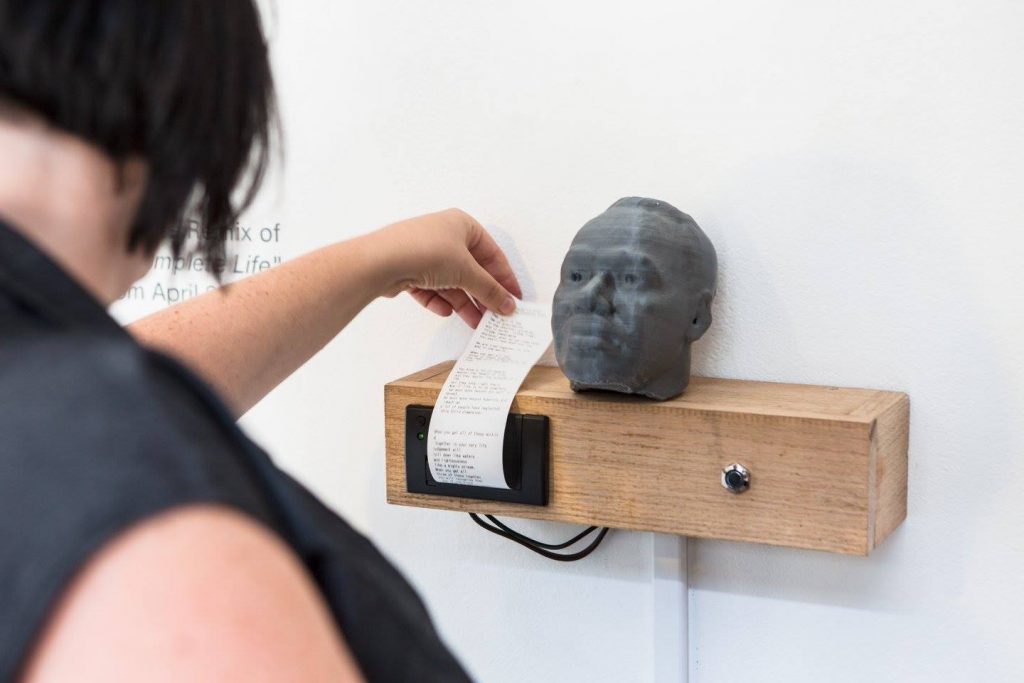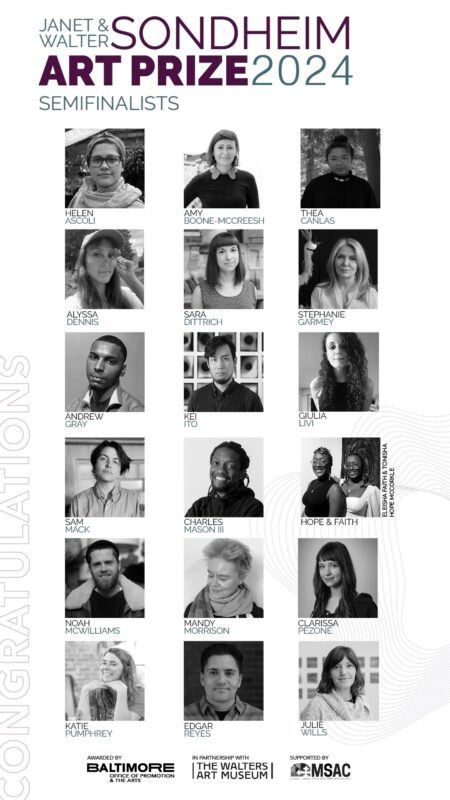The FreeSpace Collective engages with DC Public Library’s new Maker-In-Residence (MIR) program to culminate in a show at Flashpoint Gallery
by Eames Armstrong
Access to photocopy machines and printers is still an important service that libraries provide, but today DC Public Library patrons can also access laser cutters and 3D printers. Of course, there is a learning curve. And now that we can use MakerSpace equipment, what on earth should we do with it?
Last summer DC Public Library launched a new Maker-In-Residence (MIR) program. The FreeSpace Collective, artists Billy Friebele & Mike Dax Iacovone, were chosen to pilot this new initiative based at the MakerSpace in the downtown Martin Luther King Jr. branch. Since I first read about the MIR, I thought it was a smart idea: invite artists into this uncharted part of the library to lead by example, and create a unique platform for new projects to develop and be seen.

Over the year-long residency, the artists learned to use the equipment for their own projects and led public workshops. The culmination of this residency is an exhibition, City of Ghosts at CulturalDC’s Flashpoint Gallery, located just across the street from MLK Library.
Mike and Billy have been working together as FreeSpace Collective since 2008 when they were both in grad school at MICA. Rather than their usual collaboratively created works, this exhibition consists of projects that the two artists made individually, though in tandem. Billy focused on the areas immediately surrounding MLK library, such as the rapidly changing Chinatown neighborhood, and Mike made projection pieces that visualized and mapped data such as the annual homicide rate in DC.
I’ve known both artists for a while, and have anxiously waited to see how the MIR program went. I asked them about their experience as Maker-In-Residence and their resulting and ongoing projects.
CulturalDC announced recently that Flashpoint Gallery will close sometime next year after thirteen years. I’m pleased, if bittersweetly, that I’ll be among the last artists who will show there in January 2017. So I also asked about Mike and Billy about the future for artist spaces and the possible role of libraries. (Full disclosure: Two years ago Mike invited me to speak to a class he designed and taught at the Corcoran called ‘Art Outside the Gallery’ and Mike is a regular contributor to BmoreArt.)
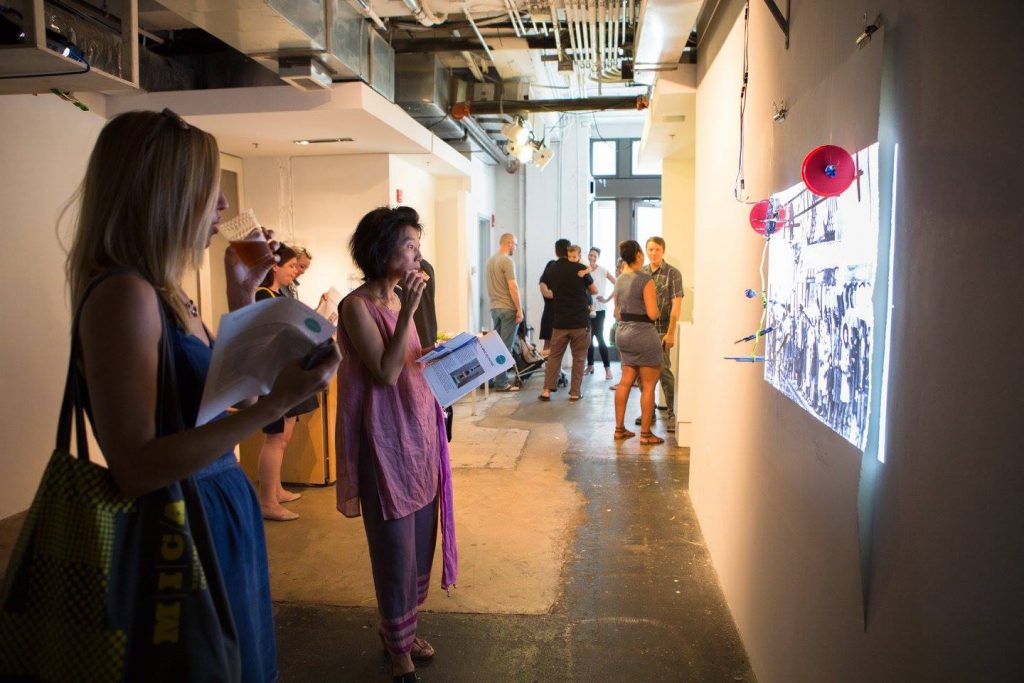
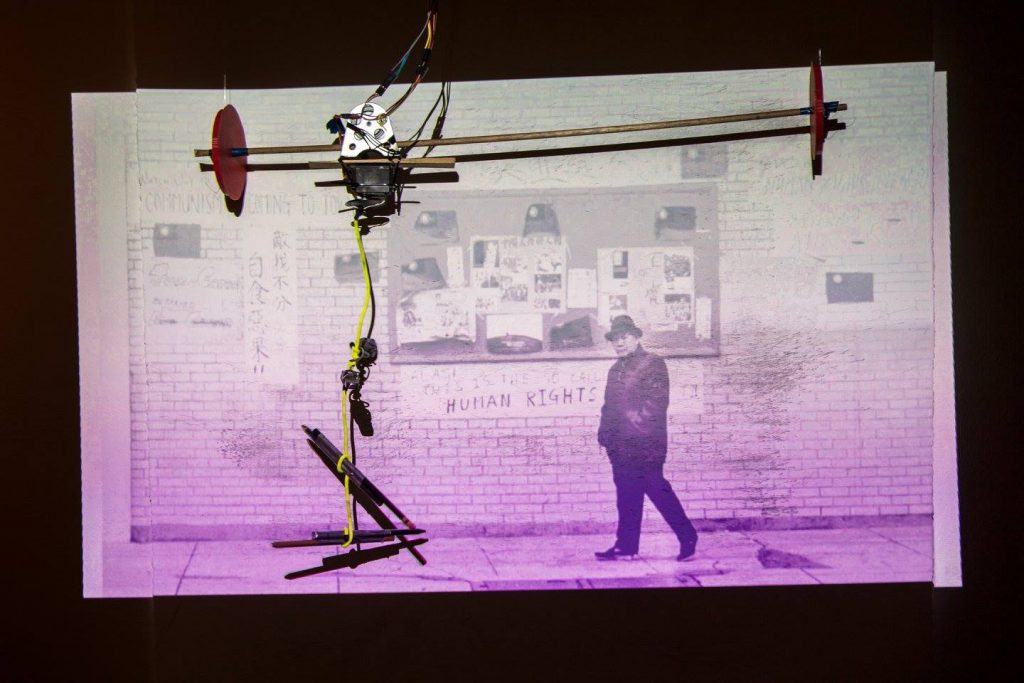 Winds of Time (over 100 years), 2016
Winds of Time (over 100 years), 2016
Eames Armstrong: The neighborhood around the MLK Library directly influenced several of the pieces in the exhibition, such as Future Monument for Chinatown, DC 2016 and Winds of Time (over 100 years). What was your relationship with that area like before, and now?
Billy Friebele: I grew up in PG county and vividly remember driving through Chinatown in the 80’s and seeing this desolate, partly vacant landscape. It was known to be a dangerous area. When Ted Leonsis decided to build the MCI center in that area it was a catalyst for change, and the effects are still rippling today. My 23 year-old cousin just moved to DC and decided to move to Chinatown, which represents a major shift in my lifetime.
The residency led me to focus much more closely on this area. I researched the historical changes over time as well as the contemporary tensions between rapid development and the Section 8 housing of buildings like the Wah Luck House and Museum Square.
The act of physically capturing 3D scans of these areas really brought me in contact with the streets in ways I would have never engaged. That is one of the reasons that Mike and I have been working with public spaces for so long, because it leads us to see and experience areas of the city in new ways.
Random Access Remix of “The Three Dimensions of a Complete Life” by Martin Luther King Jr
A lasting image that sparked the Future Monument piece was seeing a row house propped on stilts, next to a lot that had been dug out. In one space you could see this enormous core sample of the area, from the dirt under the concrete, to the historical, to the condos stretching high above. This led to the idea of this space as a process of stacking, layering, and parts being metabolically digested to create new forms. (that idea is from Gordon Matta-Clark)
To take a 3D scan you have to circle an object several times from different angles, and doing that requires that you behave differently than people normally act in public, but it also means that you are focused on looking closely at the details. I found that the 3D scanning project led me to constantly look for objects and forms in the city, and in this area, that were being overlooked. I have a new perspective on this space, and after visiting these sites at different times of day I feel a connection with them.
The scanning project is an attempt to archive the current moment in this specific location, and to celebrate the mundane and everyday, as well as ornate architectural features that may be erased in short time.
Mike Dax Iacovone: For me, the pieces I worked on all treated the city as one entity, instead of focusing on the area around the gallery and the library. I’ve been making work about DC for a long time, and the research I did for my work didn’t really change the way I think about the city because I was aware of most of it. Essentially what I want is for the work to get that information across to the viewer. We’re all familiar with the shape of DC, and I think most people can do a reasonably good job locating where they are within the shape of DC. So then if they’re looking at the Homicide Projectors, or [ANC Statistics], they can see how their spaces relate to the other spaces of the city.
EA: Overall do you think the Maker-In-Residence program was successful? what would you change if they do this residency again?
BF: For us the residency was hugely successful and beneficial. Because the space is so new, and the library is undergoing such changes, I think that there is a lot of untapped potential that could really be utilized in the future. For instance, we tried to branch out and hold workshops across the city, hoping to engage folks from many different areas, but it was difficult to gain traction and lack of communication with the library friends groups ultimately made that impossible. So, our interactions with MLK Library and Tenley-Friendship Library were fantastic, but there is certainly room to expand to other neighborhoods.
Also, I just want to say that the Tenley Friends of the Library were so engaged and welcoming. We really felt a warm response to our workshops there in ways that went beyond the scope of more traditional gallery talks.
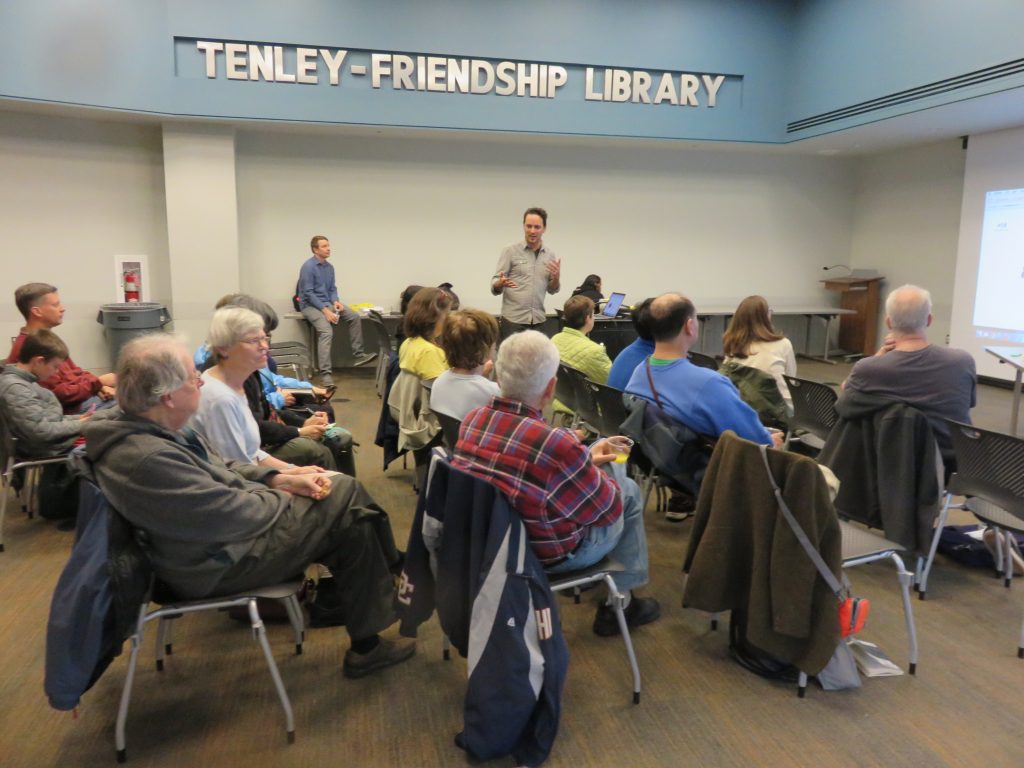
MI: The residency really worked out for us. We made work we probably wouldn’t have otherwise made, and we engaged with people we probably wouldn’t have. And most importantly we gained the skills we needed on the equipment to make this work, but also to have that in our arsenal for future work.
EA: Do you imagine, or hope, that libraries (and MLK in particular) could play an even bigger role as art exhibition spaces in the future?
BF: Yes, and I think both parties would really benefit from this. Libraries need to get people in the doors, and maker spaces are an example of rethinking the model. So many artists utilize research and are adept at connecting to the public, so the benefits are so obvious. Really it’s a question of having the staff and resources to manage and support the residents. We were lucky to work as a collaborative team, but I think more support and assistance in making connections with the public is important.
MI: Yeah, I think that libraries in general, and MLK specifically, have done a great job in evolving and remaining relevant. I think 10 years ago I probably assumed we didn’t need libraries anymore, but they fill incredibly important needs in the community. MLK has been doing a great job in making space for art, and I think that will continue to grow. And more importantly, it’s pretty obvious that the paradigm of showing art in dedicated galleries is in need or repair.
To begin with, it alienates the public from actually going to see it, and it ends with not being a financially viable model. There are certainly some galleries that do a good job, but there are fewer art galleries in this city every year. And I don’t think that’s entirely a bad thing. I think it spurs artists to think differently about where work should go, and it’s the impetus for DIY and PopUp spaces. And it makes spaces like MLK library more culturally important. I think in general we all hate to see the galleries close, but it doesn’t make artists go away, it pushes them into considering other possibilities.

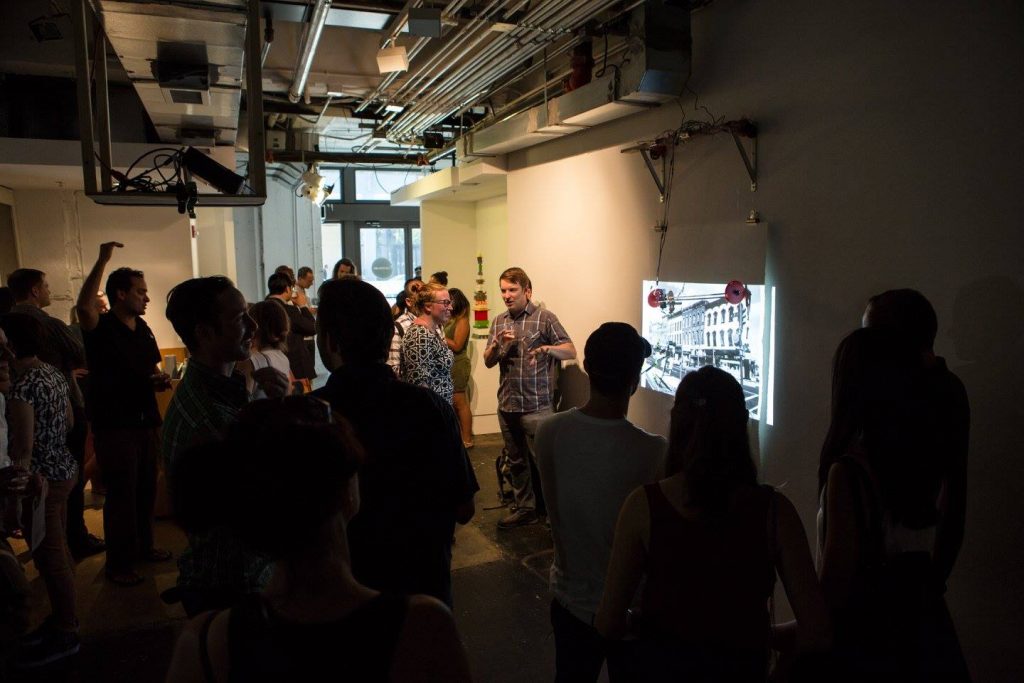
EA: If you could invent artist residencies at other organizations, public spaces, museums, companies, etc- what would they be? Whether practical and purposeful like with MIR at MLK. or a fantasy residency situation…
MI: If I were to invent a residency, I think I’d make it so it was about collaboration. I’d like the artists to come in and show what they do and what their interests are, and then I’d like to see if they can collectively create something new.
BF: Great idea! I think sports franchises should have resident artists since they have a good revenue flow and have a built in viewing public.
On a more realistic note, it seems like every historical museum could benefit from an artist residency that could work on connecting to the public in new contemporary ways.
What if Metro decided to have an artist in residence? They need help connecting with the public. I can just imagine artists doing performance pieces or setting up easels on trains.
 2013 Homicide Projector
2013 Homicide Projector 2015 Homicide Projector
2015 Homicide Projector
EA: Well Metro does have Art in Transit and MetroPerforms! programs, but they seem to be pretty restrictive and performance opportunities are unpaid. Any predictions for how dc art spaces will look/function 10, 20 years from now?
BF: Everything is moving east at the moment. I live in Hyattsville and the art scene is thriving. DC is unique in that there is a hard-line border between the city and state, so artists get caught on one side or the other, and this affects things like applying for grants, residencies, shows etc. At the same time, Baltimore is so close, and much more affordable than DC for artists. My prediction is that if the current trends continue, we’ll see more and more artists and galleries moving to the periphery.
MI: I think the future we will see more artists pushing to make things happen for themselves instead of hoping galleries will notice them. I also think that art doesn’t need to be designated as such, and in calling it ‘art’ it already starts turning most people away. If we start thinking about these things as experiences and social commentary that people will be more likely to experience it.
EA: Has a community developed around the FabLab, and if so what is your relationship to, or within, that community? Are you going to continue to use that space?
BF: We really enjoyed working with the librarians in the FabLab sharing ideas and seeing what others are doing with these evolving technologies. I found the space to be great for brainstorming because everyone is essentially trying to figure this stuff out and problem solve, and they are coming from so many different fields (outside of art). So, I will definitely try to interact with that space going forward. Similar to our collaborative projects, it’s just great to interact and converse about the projects rather than working out of a lonely basement (which I also did quite a bit!)
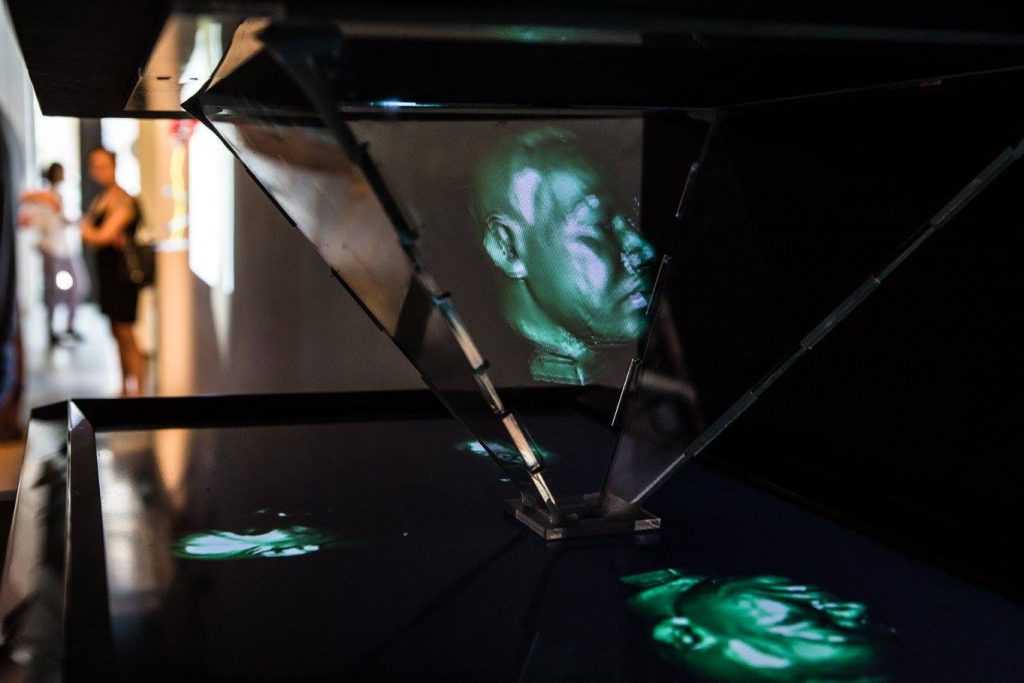 MLK Hologram
MLK Hologram
EA: Did the images in Winds of Time (over 100 years) come from MLK archives?
BF: Yes. I used the Washingtonia collection at the MLK Library to find images of Chinatown from the the last 100 + years.
EA: In making these pieces did you come across any other interesting bits of research that didn’t make it into the show?
MI: Yeah there’s a lot of research I collected that didn’t make it in to the show because I think I was in danger of putting too much information into a piece. I didn’t use some information I collected on how many people receive food stamps, and college graduation rates and stuff like that. I also have collected the homicide locations since 2001, but only used the last four years because I wanted the information to be recent, and to point at the current state of things instead of the past.
BF: More than research into the history of DC (most of that research made it into the show), there are a ton of technological experiments on the cutting room floor, like a robotic piece that runs into walls and then turns around, some hacks using GPS, a few kinetic pieces that failed…
 ANC Statistics with 2016 Homicide Map, 2016
ANC Statistics with 2016 Homicide Map, 2016
EA: MakerSpace or FabLab stuff is often packaged as if all these new possibilities for making are suddenly accessible and available, but it sometimes seems to me like the limitations could outweigh the benefits of more traditional art making process. I see pros and cons, like 3d scanning and 3d printing an object versus casting a mold of the same object. Did you find that there are some applications of the equipment that are particularly useful? And on the flip side was this technology at all limiting to what you hoped to accomplish?
MI: I’d say that if you’re presented with an opportunity to make ‘anything’ it’s pretty difficult to narrow that down into something you actually want to do. And we did have to wrestle with that a little. It’s hard to not get seduced by the equipment and forget that there needs to be an end goal. I tried a lot of little projects that were kind of aimless, like at one point, I made a cardboard shark with the laser cutter. It was fun, and I was learning the equipment, but ultimately it was useless and thrown away. But it was a good step in thinking about the laser cutter both in its possibilities and in limits.
BF: Well, every tool has limitation, and in the beginning we were a bit frozen by all the possibilities, and also the thought that whatever we produce will inevitably look “so 2016” in the future, but by the end the limitations started to become generators for the concepts. For instance, printing in 3D with PLA is a low-fi process. I was trying to archive the memory of architectural fragments. After scanning the objects, manipulating them with software and then printing in plastic, they become abstractions with artifacts from all of the translations. This started to align with the idea of these ghost forms or memorial objects that trigger memories but are themselves hollow, and sometimes defective.
The limitations of the 3D scanner meant that I could only capture forms that are about 3′ on all sides. This also led to the idea of fragmentation and steered me away from being able to capture large signifiers of place. So, in other words, it forced me to look at small, unnoticed objects or fragments.
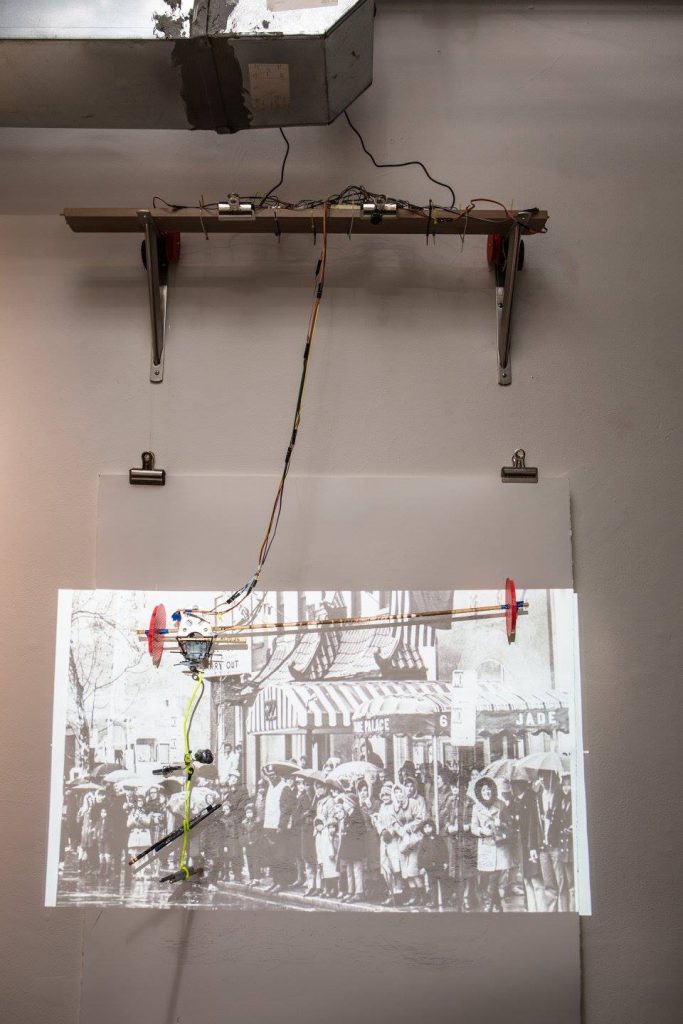 Winds of Trime (over 100 years)
Winds of Trime (over 100 years)
EA: Whats next? individually, and/or collectively?
BF: I feel like this has opened a lot of doors for us in terms of the tool set we can use to produce our projects. Essentially this show is a collection of experiments, and each one has room to expand. Usually we start with a specific concept, create sets of rules, and then the process of creation is kind of a rote task (so it is more front-loaded creatively speaking), and this process was sort of the opposite. We were forced to try new things, and let ideas sink or swim, and I think that will broaden our ability to let the process become generative.
Collaboration is a conversation. We’ve been having a similar conversation for years, and now I feel like we’ve been given a new mode of communication to exchange ideas.
MI: Individually, we’ll both still work in different directions, and I imagine the FabLab tools will play a part in that to some extent.
I’m not quite sure how yet, because my next couple months will be working with a bunch of video I shot of digging holes out in the desert earlier in the summer, although I will probably create some sort of map to show the locations that might make it’s way through the laser cutter. Collectively we have a collaboration that’s in the early stages that will probably end up in the technology phase on the way to completion.
Thank you so much!
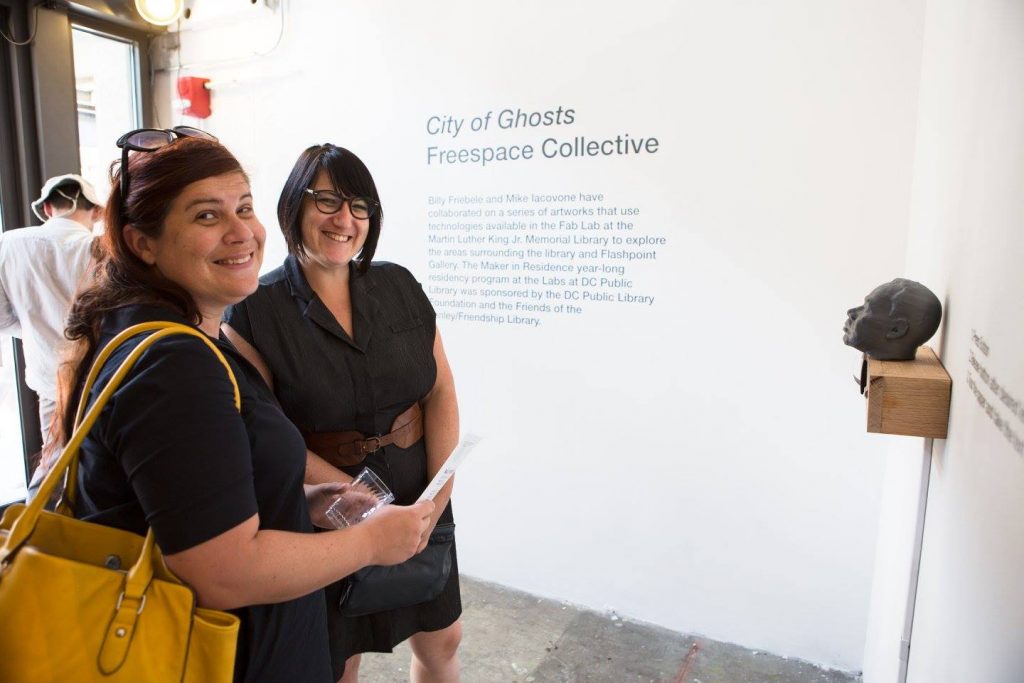
*****
City of Ghosts is on view at Flashpoint Gallery through September 10.
Author Eames Armstrong works in performance, noise, language, and time. Eames is based in Washington, D.C. where they organize performance events and exhibitions.
All Photos by Tony Hitchcock

